The Basic
Guards of Medieval Longsword
One of the most important elements of historical fencing study is
that of basic fighting stances and guard positions. Nothing is more
fundamental than these two things. Stances or guards (leger/huten
or guardia/posta) are in many ways the very foundation of Medieval
swordsmanship. The offensive and defensive postures and ready positions
from which to deliver all manner of blows lie at the heart of any
fighting method. Unquestionably, they represent the
beginning of study. All principles and techniques of fighting
all are employed in relation to these postures.
But they are not "static" postures, but
dynamic "ready positions" from which to strike or counter-strike.

The basic 4 from the Solothurner Fechtbuch
The primary postures or ready positions
for long-swords, those which date back to master Liechtenauer in the
1380’s (and likely the 1360’s if not earlier) are: Ochs, Pflug, Alber,
and Vom Tag. These
are: the Ox, the Plow, the Fool, the Roof. These
of course correspond to in the middle (“Plow”), outside
high/horizontal pointing ("Ox"), low (“Fool”),
and high (“Roof”).
Other spellings of Vom Tag are Vom Tach or Vom
Dach. The
14th century German grand Fechtmeister, Johannes Liechtenauer
as did many of his later heirs taught only the first four guards.
To this we can add a fifth, the Nebenhut ("near ward")
or “Tail” (a “back” guard), called Posta di Coda lunga distesa (“Long Lying Tail”)
by Fiore Dei Liberi in 1410
(although not included as primary, it appeared frequently in subsequent
German works). Thus,
five basic fundamental stances or guards are used with nearly all
forms of Medieval long-swords. Virtually all the masters
taught these primary positions or variations of them.
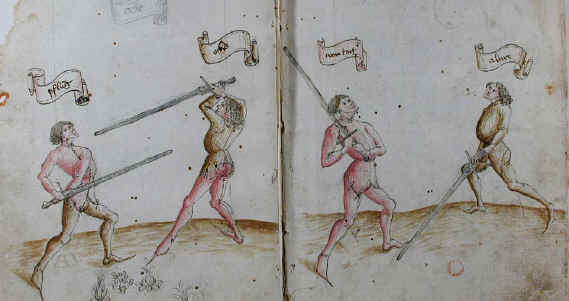 . .
The basic 4 conventiently labled from Peter Von Danzig, 1449.
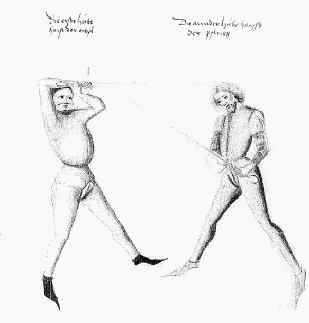 |
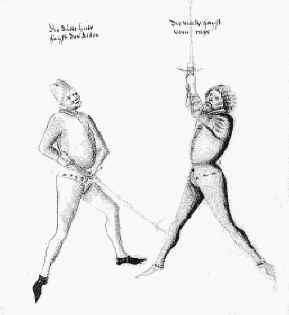 |
Ochs, Pflug, Alber, and Vom Tach from Palus
Kal's Fechtbuch c. 1480.
Note the slight variations in hand and hilt positions from others. |
These
five guards can each transition one to any other and such should
always be practiced as a fundamental training exercise. Begin
these stances with a left leg leading, sword in right hand. Standard
ARMA long-sword curriculum utilizes all of these in conjunction with
other stances in our exercises and practice routines. The transition
between these stances should be fluid and smooth, and may or may not
involve passing forward the rear foor or passing back the front foot.
There is a substantial amount of information that can be conveyed
about each stance, their variations, how to move into or out of each,
and what actions they provides for. This short article does not cover
that material, only introduce these proper five primary guards.
In addition to these 5 "primary" stances, there are others
important (such as Iron Door, Vechsel, etc.) that could be called
"secondary" stances. Of these, 6 are "symmetrical"
and can be done as left or right side versions.
The Major Longsword Guards of the German School
|
|
|
The
first position, Ochs ("ox"), essentially
assumed by drawing the weapon up and to the "outside".
The point may aim somewhat downward or upward but typically
aimed at the opponent's face or throat. This was called Finestra
or "window" in Italian schools.
|
|
|
|
Note the blade alignment by observing
the angle of the cross, the blade is neither vertical nor horzontal
but slightly diagonal, in fact, the natural position acheived
by cutting upward. In this position note the short (back) edge
aims not upward or downward but toward the fighter, while the
thumb is under the blade, not on top of it.
|
|
|
|
The hilt is held just in front
of beside or the head at temple level, but may be also held
just above it. Also, the Ochs is not a "hanging
point" or hanging guard position. The Ochs position,
although not as stable as others, protects well, allows a direct
threat with its straight thrust, turn to cut diagonally downward,
or pull back to cut from underneath.
|
|
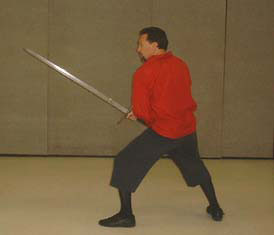
|
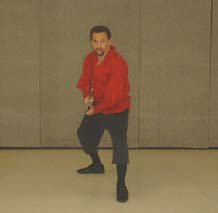
|
Lowering the weapon
to the middle acheives the second position or Pflug
("plow"). Either passing or making a single small step
of the foot in transition is useful here. The point should aim
at the opponent's chest or throat and the hilt should be held
more off to the side in front of the hip joint rather than dead
center between the legs. Note that depending on which leg leads
in the Pflug, the hip the pommel is in front changes.
|
|
|
|
There are a few variations
of this position such as puling the hilt further back near or
even past the hip. Some masters are specific that on
the right side, the stance is held with the long edge down but
that on the left side it is held long edge up (in effect, merely
a lowered a left Ochs). This "long Pflug" (for
lack of a term) permits a quick cut under from behind as well
as allowing better donward thrusts. |
|
|
|
Each of these left plow positions,
long edge up and long edge down, appear in the source texts. To
acheive either the left hand should simply keep a looser grip
to allow it turn while the right maintains normal grip pressure.
The long edge down position permits quick slices and upward thrusts.
Overall the plow protects and covers very well while permitting
all attacks. |
|
|
|
The third position is Alber
("fool"), acheived by lowering the point with the
hands (and making a pass of the foot, forward or back,
in transition). Either leg may lead. The weapon is held point
down, ussualy between the legs rather than outside of or next
to them. This guard is also the "middle iron door" of
the Italians. The position is deceptively open and allows for
quick counter strikes. |
|
|
|
The fourth is "from the
roof", Vom Dach/Vom Tag (an
Oberhut), by raising the weapon up with the shoulders (held
at roughly 45-degrees, not horizontal). Passing the foot is useful
in transitioning here. The position is both threatening and warding.
It easily lowers to any other stance or turns to the ox. |
|
|
|
The "roof" guard
may also be placed over the (generally right side) shoulder rather
than over the head. The hilt can be above or in front of the collar,
but not down in front of the chest. Note the blade is neither
angled behind the head, nor held horizontal, nor resting on the
shoulder. Some armors prevent holding the weapon above the head,
hence the side version. More stable than held above the head,
the position still permits a variety of threats and counters.
This position easily turns around into ox or drops down to plow. |
|
|
|
When held over the shoulder strikes
are quicker and more deceptive but have somewhat less range and
strength. Note that depending upon the angle and prior action,
the stance can appear as if the weapon is held behind
the head or neck, when in fact, this is just an illusion created
by a turn of the waist. |
|
|
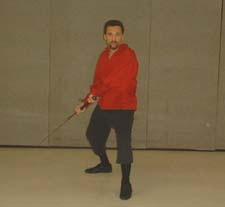
|
In addition the four above, a
fifth position is the Nebenhut
("near ward"), assumed by rotating the weapon down
and to the side from above. Passing the foot again is useful
in transitioning here. In Italian this is called Posta Coda
Longa ("tail" or "long tail"). Note
on the right side here the point slants downward and behind,
not off to the side, with the long edge aiming forward at the
opponent, not at the ground. This permits a strong rising cut
with the long edge, ending in an ox position. Otherwise, if
held with the short edge forward (such as in a left side posture),
a full upward cut with the back of the blade end in the roof
position. While somewhat inviting, the Neben stance is
also meanacing and deceptive.
As with all the stances, except plow, the sword
is held essentially on a 45-degree angle. The tail easily lifts
to the roof or rises up into an ox on the opposite side.
|
| Excellent detailed descriptions of longsword stances
come to us from the Fechtbuch of Jud Lew (c.1450-1455)
which clarifies several points. In the right side Plow
for example, we are told to hold the sword "with the hands
crossed below" and "the pommel close to the right hip"
short edge up. This makes perfect sense given the turned and pulled
back posture the stance inspires. For the left side Plow,
we are told only to hold the sword "close to the left side
below the left hip" long edge up. In the Fool we are
told to hold the sword "with arms stretched in front…the
point on the ground." The arms are thus not kept bent and
against the body, but whether this means literally resting the
blade upon the ground is questionable. For the Roof, we
are told to stand holding the "sword with uncrossed hands
high over the head" so that the "point hangs a little
backwards." This implies the weapon is held upward in the
middle and not angling to the left or right, but is unclear whether
the point should actually come down below the head (as in a Zornhut)
or merely directed back behind the swordsman more naturally. |
|
|
|
Note: To assist students in learning this weapon, I have found
it very effective to rely on a modern generic names (high, middle,
low, outside, etc.) for the most fundamental postures and positions
universal to most all the Medieval and early Renaissance long-sword
source texts. But in moving beyond such a useful
holistic approach, toward a more precise understanding of the fighting
styles of each historical text, we start to note the differences between
Masters. Some of these terms and positions we study correct or supercede
ones listed in my 1998, Medieval Swordsmanship, book (itself
researched in '96). The tentative nature of historical research means
that some terms and names as well as postures have been amended and
corrected from those in the book. However, this clarification does
not invalidate the generalized fighting postures presented in the
book’s overview of stances, or the tactical understanding provided
therein.
- John C., ARMA Director, May 2001.
Updated Nov. 2003 / Oct 2004.
|

